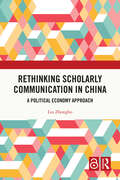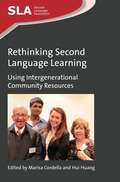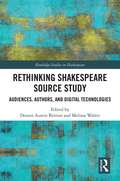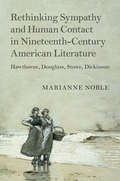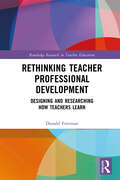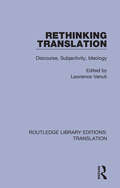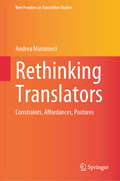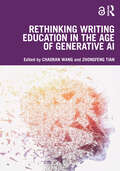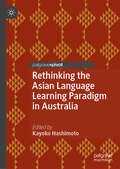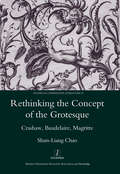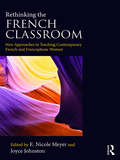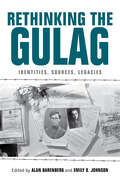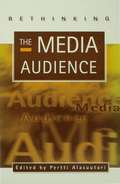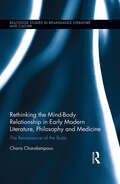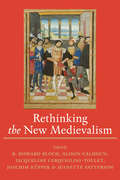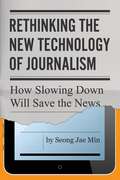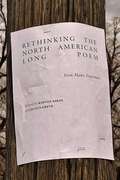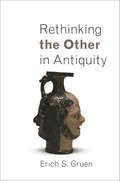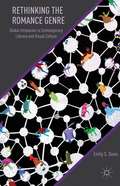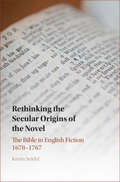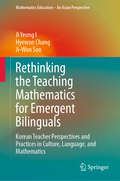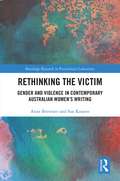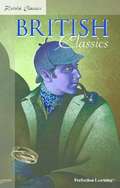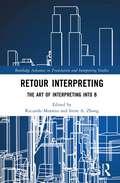- Table View
- List View
Rethinking Scholarly Communication in China: A Political Economy Approach
by Liu ZhongboThis book examines science and technology policies in China over time and explores the development of scholarly communication through the lens of the political economy of communication.Despite political censorship and restrictions on the production of academic knowledge in China, the number of scholarly publications has skyrocketed over the past 20 years. By explaining these seemingly contradictory phenomena, this study provides insight into the complex landscape of scholarly communication in China, shaped by the government in collaboration with commercial publishers. The book examines the dynamic relationship between the state and the market, including their key players, which determines the production and dissemination of academic knowledge. From a political economy perspective, it investigates how the academic governance complex, a system that intertwines communication, politics, and economics, has been established in China. It then discusses the impact of this system on the production of academic knowledge in the country.The title will serve as a key reference for academics, researchers, and students interested in the intersection of communication studies, librarianship, and political science, particularly those focusing on China's academic knowledge production and scholarly communication.
Rethinking Second Language Learning: Using Intergenerational Community Resources
by Hui Huang Marisa CordellaThis book evaluates a project where formal classroom learning of a second language was supplemented with informal, natural interactions with older native speakers of the target language, delivering a number of pedagogical and societal benefits. The authors introduce a model of intergenerational, intercultural encounters which aims to promote the use of community language resources; enrich the experiences of young learners; foster greater understanding between generations; break down cultural stereotypes; encourage appreciation of different cultures and enhance the quality of life and community engagement of older people with a bi/multilingual background. It draws on theories of language acquisition, discourse analysis and psychosocial perspectives to propose a model of language learning for students that can be used for any language or locality. It is therefore an essential resource for graduate students, researchers and language teachers as well as for education, aged and youth care policy makers, practitioners and community services workers who are interested in innovative language pedagogy.
Rethinking Shakespeare Source Study: Audiences, Authors, and Digital Technologies (Routledge Studies in Shakespeare)
by Dennis Austin Britton Melissa WalterThis book asks new questions about how and why Shakespeare engages with source material, and about what should be counted as sources in Shakespeare studies. The essays demonstrate that source study remains an indispensable mode of inquiry for understanding Shakespeare, his authorship and audiences, and early modern gender, racial, and class relations, as well as for considering how new technologies have and will continue to redefine our understanding of the materials Shakespeare used to compose his plays. Although source study has been used in the past to construct a conservative view of Shakespeare and his genius, the volume argues that a rethought Shakespearean source study provides opportunities to examine models and practices of cultural exchange and memory, and to value specific cultures and difference. Informed by contemporary approaches to literature and culture, the essays revise conceptions of sources and intertextuality to include terms like "haunting," "sustainability," "microscopic sources," "contamination," "fragmentary circulation" and "cultural conservation." They maintain an awareness of the heterogeneity of cultures along lines of class, religious affiliation, and race, seeking to enhance the opportunity to register diverse ideas and frameworks imported from foreign material and distant sources. The volume not only examines print culture, but also material culture, theatrical paradigms, generic assumptions, and oral narratives. It considers how digital technologies alter how we find sources and see connections among texts. This book asserts that how critics assess and acknowledge Shakespeare’s sources remains interpretively and politically significant; source study and its legacy continues to shape the image of Shakespeare and his authorship. The collection will be valuable to those interested in the relationships between Shakespeare’s work and other texts, those seeking to understand how the legacy of source study has shaped Shakespeare as a cultural phenomenon, and those studying source study, early modern authorship, implications of digital tools in early modern studies, and early modern literary culture.
Rethinking Sympathy and Human Contact in Nineteenth-Century American Literature: Hawthorne, Douglass, Stowe, Dickinson (Cambridge Studies in American Literature and Culture #182)
by Marianne NobleIn accessible and impassioned discussions of literature and philosophy, this book reveals a surprising approach to the intractable problem of human contact. Nathaniel Hawthorne, Frederick Douglass, Harriet Beecher Stowe, and Emily Dickinson rethought the nature of human contact, turning away from transcendentalist approaches and towards sympathetic ones. Their second and third works portray social masks as insufficient, not deceptive, and thus human contact requires not violent striking through the mask but benevolent skepticism towards persons. They imagine that people feel real in a real world with real others when they care for others for the other's sake and when they make caring relationships the cornerstone of their own being. Grounded in philosophies of sympathy - including Adam Smith and J. G. Herder - and relational psychology - Winnicott and Benjamin - Rethinking Sympathy and Human Contact in Nineteenth-Century American Literature shows that antebellum literature rejects individualist definitions of the human and locates the antidote to human disconnection in sympathy.
Rethinking Teacher Professional Development: Designing and Researching How Teachers Learn (Routledge Research in Teacher Education)
by Donald FreemanThis book presents a new set of ideas to challenge established thinking and to guide researching and designing teacher professional development. Grounded in the work of the Learning4Teaching Project which documented public-sector teachers’ experiences and learning from professional development in three countries, the volume presents a sociomaterial perspective on teacher sensemaking. This teacher-centered perspective disputes the "conventional calculus" in which teachers learn content that they apply in their classrooms. Part I outlines conventional issues in how teacher learning and professional development have been conceptualized and studied; Part II introduces a new group of concepts that rethink these assumptions; and Part III offers important insights to inform professional development across disciplines, cultures, and contexts. Written by a leading international teacher educator in an accessible style that incorporates visual representations and project data, the book will appeal to practitioners, scholars, and researchers who design and research how teachers learn in professional development.
Rethinking Translation: Discourse, Subjectivity, Ideology (Routledge Library Editions: Translation #2)
by Lawrence VenutiOriginally published in 1992 Rethinking Translation makes the translator’s activity more visible by using critical theory. It examines the selection of the foreign text and the implementation of translation strategies; the reception of the translated text, and the theories of translation offered by philosophers, critics and translators themselves. The book constitutes a rethinking that is both philosophical and political, taking into account social and ideological dimensions, as well as questions of language and subjectivity. Covering a number of genres and national literatures, this collection of essays demonstrates the power wielded by translators in the formation of literary canons and cultural identities, and recognises the appropriative and imperialist movements in every act of translation.
Rethinking Translators: Constraints, Affordances, Postures (New Frontiers in Translation Studies)
by Andrea MusumeciThis book introduces a new area of research known as "translator's posture". With technical, pedagogical, and sociological dimension, posture is valuable to learners, researchers, educators, and practitioners alike. The technical dimension aims to invite practitioners and more advanced learners to reflect on their position within translation environments and establish their posture as translators with more ecological awareness. The pedagogical framework is grounded in an original conceptual exploration of translation constraints, leading to an ecologically inspired perspective on translation affordances. The sociological aspect draws on the notion of authorial posture in sociology of literature. The book also presents the action research data collection from a translation theory module in a Hong Kong University, supporting the integration of postural learning into curricula. This book aims to benefit global academic and professional communities in translation studies.
Rethinking Writing Education in the Age of Generative AI
by Zhongfeng Tian Chaoran WangBringing together leading scholars and practitioners, Rethinking Writing Education in the Age of Generative AI offers a timely exploration of pressing issues in writing pedagogies within an increasingly AI-mediated educational landscape.From conceptual and empirical work to theory-guided praxis, the book situates the challenges we face today within the historical evolution of writing education and our evolving relationship with AI technologies. Covering a range of contexts such as L2/multilingual writing, first-year writing, writing centers, and writing program administration and faculty development, the book examines various AI-informed writing pedagogies and practices. Drawing on interdisciplinary perspectives from writing studies, education, and applied linguistics, the book bridges theory and practice to address critical questions of innovation, ethics, and equity in AI-supported teaching.This book is essential for writing educators and researchers looking to leverage AIs to facilitate the teaching and learning of writing in critical and transformative ways.
Rethinking the Asian Language Learning Paradigm in Australia
by Kayoko HashimotoThis edited book calls for a rethink of the current Asian language learning paradigm that frames Asian languages as strategic and economic tools, rather than an inherent part of Australian society. As an increasing number of Australians have Asian ancestry and speak languages other than English at home, it argues that we must reset the paradigm and understand Asian languages as intrinsically Australian to maximise existing linguistic and cultural assets. The interdisciplinary chapters, focusing on Japanese, Chinese, Korean and Vietnamese, report on the state of Asian language learning and teaching in mainstream educational settings as well as heritage language education in informal contexts in Australia. With an additional chapter on implications for other Anglophone countries, this volume urges a transformative approach to Asian language education in the context of current global migration and multilingual demographics in order to nurture global citizenship and honour linguistic diversity. The book will be suitable for academics, policy makers, practitioners and teachers.
Rethinking the Concept of the Grotesque: Crashaw, Baudelaire, Magritte
by Shun-Liang ChaoHow are we to define what is grotesque, in art or literature? Since the Renaissance the term has been used for anything from the fantastic to the monstrous, and been associated with many artistic genres, from the Gothic to the danse macabre. Shun-Liang Chao's new study adopts a rigorous approach by establishing contradictory physicality and the notion of metaphor as two keys to the construction of a clear identity of the grotesque. With this approach, Chao explores the imagery of Richard Crashaw, Charles Baudelaire, and Rene Magritte as individual exemplars of the grotesque in the Baroque, Romantic, and Surrealist ages, in order to suggest a lineage of this curious aesthetic and to cast light on the functions of the visual and of the verbal in evoking it.
Rethinking the French Classroom: New Approaches to Teaching Contemporary French and Francophone Women
by Joyce Johnston E. Nicole MeyerThis volume investigates how teaching practices can address the changing status of literature in the French classroom. Focusing on how women writing in French are changing the face of French Studies, opening the canon to not only new approaches to gender but to genre, expanding interdisciplinary studies and aiding scholars to rethink the teaching of literature, each chapter provides concrete strategies useful to a wide variety of classrooms and institutional contexts. Essays address how to bring French Studies and women’s and gender studies into the twenty-first century through intersections of autobiography, gender issues and technology; ways to introduce beginning and intermediate students to the rich diversity of women writing in French; strategies for teaching postcolonial writing and literary theory; and interdisciplinary approaches to expand our student audiences in the United States, Canada, or abroad. In short, revisiting how we teach, why we teach, and what we teach through the prism of women’s texts and lives while raising issues that affect cisgender women of the Hexagon, queer and other-gendered women, immigrants and residents of the postcolony attracts more openly diverse students. Whether new to the profession or seasoned educators, faculty will find new ideas to invigorate and diversify their pedagogical approaches.
Rethinking the Gulag: Identities, Sources, Legacies
by Alexander Etkind Lynne Viola Jeffrey S. Hardy Josephine Von Zitzewitz Judith Pallot Irina Anatolievna Flige Susan Grunewald Mikhail Nakonechnyi Gavin Slade Sarah J. YoungThe Soviet Gulag was one of the largest, most complex, and deadliest systems of incarceration in the 20th century. What lessons can we learn from its network of labor camps and prisons and exile settlements, which stretched across vast geographic expanses, included varied institutions, and brought together inmates from all the Soviet Union's ethnicities, professions, and social classes?Drawing on a massive body of documentary evidence, Rethinking the Gulag: Identities, Sources, Legacies explores the Soviet penal system from various disciplinary perspectives. Divided into three sections, the collection first considers "identities"—the lived experiences of contingents of detainees who have rarely figured in Gulag histories to date, such as common criminals and clerics. The second section surveys "sources" to explore the ways new research methods can revolutionize our understanding of the system. The third section studies "legacies" to reveal the aftermath of the Gulag, including the folk beliefs and traditions it has inspired and the museums built to memorialize it. While all the chapters respond to one another, each section also concludes with a reaction by a leading researcher: geographer Judith Pallot, historian Lynne Viola, and cultural historian and literary scholar Alexander Etkind.Moving away from grand metaphorical or theoretical models, Rethinking the Gulag instead unearths the complexities and nuances of experience that represent a primary focus in the new wave of Gulag studies.
Rethinking the Media Audience: The New Agenda
by Dr Pertti AlasuutariPertti Alasuutari provides a state-of-the-art summary of the field of audience research. With contributions from Ann Gray, Joke Hermes, John Tulloch and David Morley, a case is presented for a new agenda to account for the role of the media in everyday life.
Rethinking the Mind-Body Relationship in Early Modern Literature, Philosophy, and Medicine: The Renaissance of the Body (Routledge Studies in Renaissance Literature and Culture)
by Charis CharalampousThis book explores a neglected feature of intellectual history and literature in the early modern period: the ways in which the body was theorized and represented as an intelligent cognitive agent, with desires, appetites, and understandings independent of the mind. It considers the works of early modern physicians, thinkers, and literary writers who explored the phenomenon of the independent and intelligent body. Charalampous rethinks the origin of dualism that is commonly associated with Descartes, uncovering hitherto unknown lines of reception regarding a form of dualism that understands the body as capable of performing complicated forms of cognition independently of the mind. The study examines the consequences of this way of thinking about the body for contemporary philosophy, theology, and medicine, opening up new vistas of thought against which to reassess perceptions of what literature can be thought and felt to do. Sifting and assessing this evidence sheds new light on a range of historical and literary issues relating to the treatment, perception, and representation of the human body. This book examines the notion of the thinking body across a wide range of genres, topics, and authors, including Montaigne’s Essays, Spenser’s allegorical poetry, Donne’s metaphysical poetry, tragic dramaturgy, Shakespeare, and Milton’s epic poetry and shorter poems. It will be essential for those studying early modern literature, cognition, and the body.
Rethinking the New Medievalism
by R. Howard Bloch, Alison Calhoun, Jacqueline Cerquiglini- Toulet, Joachim Küpper, Jeanette Patterson,Twenty years after Stephen Nichols transformed the study of medieval literature, leaders in the field pay tribute to his work and expand on it.In the early 1990s, Stephen Nichols introduced the term "new medievalism" to describe an alternative to the traditional philological approach to the study of the romantic texts in the medieval period. While the old approach focused on formal aspects of language, this new approach was historicist and moved beyond a narrow focus on language to examine the broader social and cultural contexts in which literary works were composed and disseminated. Within the field, this transformation of medieval studies was as important as the genetic revolution to the study of biology and has had an enormous influence on the study of medieval literature. Rethinking the New Medievalism offers both a historical account of the movement and its achievements while indicating—in Nichols’s innovative spirit—still newer directions for medieval studies.The essays deal with questions of authorship, theology, and material philology and are written by members of a wide philological and critical circle that Nichols nourished for forty years. Daniel Heller-Roazen’s essay, for example, demonstrates the conjunction of the old philology and the new. In a close examination of the history of the words used for maritime raiders from Ancient Greece to the present (pirate, plunderer, bandit), Roazen draws a fine line between lawlessness and lawfulness, between judicial action and war, between war and public policy. Other contributors include Jack Abecassis, Marina Brownlee, Jacqueline Cerquiglini-Toulet, Andreas Kablitz, and Ursula Peters.
Rethinking the New Technology of Journalism: How Slowing Down Will Save the News
by Seong Jae MinNews organizations have always sought to deliver information faster and to larger audiences. But when clicks drive journalism, the result is often simplistic, sensational, and error-ridden reporting. In this book, Seong Jae Min argues in favor of "slow journalism," a growing movement that aims to produce more considered, deliberate reporting that better serves the interests of democracy.Min explores the role of technology in journalism from the printing press to artificial intelligence, documenting the hype and hope associated with each new breakthrough as well as the sometimes disappointing—and even damaging—unintended consequences. His analysis cuts through the discussion of clickbait headlines and social-media clout chasing to identify technological bells and whistles as the core problem with journalism today. At its heart, Min maintains, traditional shoe-leather reporting—knocking on doors, talking to people, careful observation and analysis—is still the best way for journalism to serve its civic purpose. Thoughtful and engaging, Rethinking the New Technology of Journalism is a compelling call for news gathering to return to its roots. Reporters, those studying and teaching journalism, and avid consumers of the media will be interested in this book.
Rethinking the New Technology of Journalism: How Slowing Down Will Save the News
by Seong Jae MinNews organizations have always sought to deliver information faster and to larger audiences. But when clicks drive journalism, the result is often simplistic, sensational, and error-ridden reporting. In this book, Seong Jae Min argues in favor of “slow journalism,” a growing movement that aims to produce more considered, deliberate reporting that better serves the interests of democracy.Min explores the role of technology in journalism from the printing press to artificial intelligence, documenting the hype and hope associated with each new breakthrough as well as the sometimes disappointing—and even damaging—unintended consequences. His analysis cuts through the discussion of clickbait headlines and social-media clout chasing to identify technological bells and whistles as the core problem with journalism today. At its heart, Min maintains, traditional shoe-leather reporting—knocking on doors, talking to people, careful observation and analysis—is still the best way for journalism to serve its civic purpose. Thoughtful and engaging, Rethinking the New Technology of Journalism is a compelling call for news gathering to return to its roots. Reporters, those studying and teaching journalism, and avid consumers of the media will be interested in this book.
Rethinking the North American Long Poem: Form, Matter, Experiment (Recencies Series: Research and Recovery in Twentieth-Century American Poetics)
by Ridvan Askin and Julius GreveFor centuries, critics, poets, poet-scholars, and philosophers have either openly proclaimed or tacitly assumed the long poem as the highest expression of literary ambition and excellence. Rethinking the North American Long Poem focuses on the North American variant of this notorious form—notorious because of its often forbidding and difficult character, particularly with respect to the dialectics of content and form, aesthetics and politics, matter and genre. In nine essays and a contextual introduction, the editors and contributors scrutinize seminal long poems by North American writers, including Walt Whitman’s “Song of Myself,” Ezra Pound’s The Cantos, Muriel Rukeyser’s The Book of the Dead, and Charles Olson’s The Maximus Poems. They also explore recent efforts that have redefined or reopened the case of the long poem, including Rachel Blau DuPlessis’s Drafts, M. NourbeSe Philip’s Zong!, and Claudia Rankine’s Citizen. Taking the categories of form, matter, and experiment as frames of conceptual reference, the book examines the ways in which material and immaterial aspects of literary practice and the philosophically and politically inscribed duality of experience and experiment are negotiated in and by North American long poems from the nineteenth century to the present.
Rethinking the Other in Antiquity (Martin Classical Lectures #27)
by Erich S. GruenPrevalent among classicists today is the notion that Greeks, Romans, and Jews enhanced their own self-perception by contrasting themselves with the so-called Other--Egyptians, Phoenicians, Ethiopians, Gauls, and other foreigners--frequently through hostile stereotypes, distortions, and caricature. In this provocative book, Erich Gruen demonstrates how the ancients found connections rather than contrasts, how they expressed admiration for the achievements and principles of other societies, and how they discerned--and even invented--kinship relations and shared roots with diverse peoples. Gruen shows how the ancients incorporated the traditions of foreign nations, and imagined blood ties and associations with distant cultures through myth, legend, and fictive histories. He looks at a host of creative tales, including those describing the founding of Thebes by the Phoenician Cadmus, Rome's embrace of Trojan and Arcadian origins, and Abraham as ancestor to the Spartans. Gruen gives in-depth readings of major texts by Aeschylus, Herodotus, Xenophon, Plutarch, Julius Caesar, Tacitus, and others, in addition to portions of the Hebrew Bible, revealing how they offer richly nuanced portraits of the alien that go well beyond stereotypes and caricature. Providing extraordinary insight into the ancient world, this controversial book explores how ancient attitudes toward the Other often expressed mutuality and connection, and not simply contrast and alienation.
Rethinking the Romance Genre
by Emily S. DavisRethinking the Romance Genre examines why the romance genre has proven such an irresistible form for contemporary writers and filmmakers as they approach global issues. In contemporary texts ranging from literary works, to films, to social media, romance facilitates a range of intimacies that offer new feminist models in the age of globalization.
Rethinking the Secular Origins of the Novel: The Bible in English Fiction 1678–1767
by Kevin SeidelLiterary histories of the novel tend to assume that religion naturally gives way to secularism, with the novel usurping the Bible after the Enlightenment. This book challenges that teleological conception of literary history by focusing on scenes in seventeenth- and eighteenth-century fiction where the Bible appears as a physical object. Situating those scenes in wider circuits of biblical criticism, Bible printing, and devotional reading, Seidel cogently demonstrates that such scenes reveal a great deal about the artistic ambitions of the novels themselves and point to the different ways those novels reconfigured their readers' relationships to the secular world. With insightful readings of the appearance of the Bible as a physical object in fiction by John Bunyan, Daniel Defoe, Samuel Richardson, Sarah Scott, Frances Sheridan, and Laurence Sterne, this book contends that the English novel rises with the English Bible, not after it.
Rethinking the Teaching Mathematics for Emergent Bilinguals: Korean Teacher Perspectives and Practices in Culture, Language, and Mathematics (Mathematics Education – An Asian Perspective)
by Ji-Won Son Hyewon Chang Ji Yeong IThis book focuses on the role of cultural background in Korean public schools, and provides essential insights into how Korean teachers perceive and respond to the transition of their classroom situations with Korean language learners. It reveals the perspectives and the practices of Korean teachers, especially with regard to multicultural students who struggle with language barriers when learning mathematics. The information provided is both relevant and topical, as teaching mathematics to linguistically and culturally diverse learners is increasingly becoming a worldwide challenge.
Rethinking the Victim: Gender and Violence in Contemporary Australian Women's Writing (Routledge Research in Postcolonial Literatures)
by Sue Kossew Anne BrewsterThis book is the first to examine gender and violence in Australian literature. It argues that literary texts by Australian women writers offer unique ways of understanding the social problem of gendered violence, bringing this often private and suppressed issue into the public sphere. It draws on the international field of violence studies to investigate how Australian women writers challenge the victim paradigm and figure women’s agencies. In doing so, it provides a theoretical context for the increasing number of contemporary literary works by Australian women writers that directly address gendered violence, an issue that has taken on urgent social and political currency. By analysing Australian women’s literary representations of gendered violence, this book rethinks victimhood and agency, particularly from a feminist perspective. One of its major innovations is that it examines mainstream Australian women’s writing alongside that of Indigenous and minoritised women. In doing so it provides insights into the interconnectedness of Australia’s diverse settler, Indigenous and diasporic histories in chapters that examine intimate partner violence, violence against Indigenous women and girls, family violence and violence against children, and the war and political violence.
Retold British Classics (Retold Tales Series)
by Kathy Myers Beth ObermillerThe Retold British Classics are stories written years ago that continue to entertain or influence today. The tales offer exciting plots, important themes, fascinating characters, and powerful language. They are stories that many people have loved to hear and share with one another. This book presents a collection of eight adapted classics.
Retour Interpreting: The Art of Interpreting into B (Routledge Advances in Translation and Interpreting Studies)
by Riccardo Moratto Irene A. ZhangThis book is a vital addition to the interpreting field, focusing on retour interpreting—interpreting from one’s native language (A) into a second language (B). This practice, once viewed as secondary, has become indispensable in today’s multilingual and multicultural contexts.As interpreters increasingly handle diverse language pairs and rising standards for bilingual communication, retour interpreting plays a critical role in bridging linguistic gaps. This book features contributions from leading experts who explore retour interpreting from theoretical, pedagogical, and practical perspectives. It examines the linguistic and cognitive challenges unique to interpreting into a non-native language, while also addressing the complex factors influencing effective B-language output. By highlighting the growing need for skilled retour interpreters, especially in multilingual institutions and post-colonial settings where former colonial languages often dominate, this book aligns itself with current professional demands. With eleven chapters, the book provides comprehensive insights into retour interpreting across different languages, contexts, and career stages.It is an essential resource for interpreters, trainers, and researchers, offering practical strategies and critical perspectives. By addressing a historically underexplored area, this work fills a significant gap, reinforcing the importance of retour interpreting in today's globalized world.
